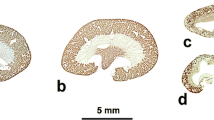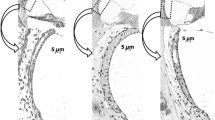Summary
The limb buds and the tail bud of rat embryos contain a mesenchymal cellular reticulum. In its axis the cells become polygonal and group to a blastema. There are no lysosomes in the cells of the surrounding mesenchyma. The cells of the central blastema, however, possess lysosomes. The primary lysosomes are cytoplasmic granules with a diameter of 0,1–0,2 μ. Their granular contents are electron dense. There is a striking occurrence of multivesiculated bodies near the Golgi zone. For their function they may be counted to the primary lysosomes. The most frequent lysosomes are the cytolysosomes. These are of circular shape with a diameter of 0,5–2 μ and are enclosed by a membrane, their contents are polymorphic. Tightly stacked granules looking like conglomerated ribosomes can be found. Apart from these other cell organelles like mitochondria and membrane structures lie in the secondary lysosomes. Finally, there are also myelin figures alone or combined with other structures in the lysosomes. The different stages of these lysosomes are the result of a partial autodigestion of cell organelles within the blastema. The autodigestion of ribosomes may be important. After this autodigestion of the old template and ribosomes a new phase of cyto-differentiation to precartilage with new template and ribosomes begins. The lysosomes show a positive reaction for acid phosphatase.
Zusammenfassung
Die Extremitätenknospen und die Schwanzknospe von Rattenembryonen enthalten ein mesenchymales Zellretikulum, in dessen Achse sich die Zellen polygonal abrunden und zu einem Blastem zusammenlegen. In den umgebenden mesenchymalen Zellen kommen keine Lysosomen vor. Dagegen enthalten die Zellen des zentralen Blastems Lysosomen. Die primären Lysosomen sind cytoplasmatische Granula mit einem Durchmesser von 0,1–0,2 μ und einem elektronendichten granulären Inhalt. Auffällig ist das Vorkommen von multivesikulären Einschlußkörpern in der Nähe der Golgizone. Wegen ihrer Funktion können sie auch zu den primären Lysosomen gerechnet werden. Die häufigsten Lysosomen sind runde Cytolysosomen (Durchmesser von 0,5–2 μ), die von einer Membran umgeben sind und polymorphen Inhalt besitzen. Dicht gepackte Granula, die wie zusammengeflossene Ribosomen aussehen, kommen vor. Außerdem liegen andere Zellorganellen (Mitochondrien, Membranstrukturen) in den sekundären Lysosomen. Schließlich kommen auch Myelinfiguren, allein oder mit anderen Strukturen kombiniert, in ihnen vor. Die verschiedenen Stadien dieser Lysosomen sind der Ausdruck für eine partielle Autodigestion von Zellorganellen im Blastem. Eine Autodigestion von Ribosomen könnte eine Bedeutung haben. Nach dieser Autodigestion der alten Information und der Ribosomen beginnt nämlich eine Zelldifferenzierung zu Vorknorpel mit neuer Information und neuen Ribosomen für die jetzt neu auftretende Zwischensubstanz. Die beschriebenen Lysosomen zeigen eine positive elektronenmikroskopisch nachweisbare Reaktion auf saure Phosphatase.
Similar content being viewed by others
Literatur
Behnke, O.: Demonstration of acid phosphatase containing granules and cytoplasmic bodies in the epithelium of foetal rat duodenum during certain stages of differentiation. J. Cell Biol. 18, 251–265 (1963).
Brachet, J., M. Decroby-Briers, et J. Hoyez: Contribution a l'étude des lysosomes au cours du développement embryonaire. Bull. Soc. Chim. biol. (Paris) 40, 2039–2048 (1958).
Duve, C. de: Lysosomes, a new group of cytoplasmic particles. In: Subcellular particles (T. Hayashi, ed.), p. 128–159. New York: The Ronald Press Co. 1959.
—: The lysosome concept. In: Lysosomes (Renk u. Cameron, ed.). London: Churchill 1963.
Jurand, A.: Ultrastructural aspects of early development of the fore-limb buds in the chick and the mouse. Proc. roy. Soc. B 162, 387–405 (1965).
Lehmann, F. E.: Zellbiologische und biochemische Probleme der Morphogenese. In: Induktion und Morphogenese. 13. Coll. der Ges. Physiol. Chemie. Berlin-Göttingen-Heidelberg: Springer 1963.
Merker, H.-J.: Struktur und Funktion der Lysosomen. Materia Med. Nordmark 17, 684–699 (1965).
Milaire, J.: Le rôle de la cape apicale dans la formation des membres des vertébrés. Ann. Soc. zool. Belg. 91, 129–145 (1961).
—: Étude morphologique et cytochimique du développement des membres chez la souris et chez la taupe. Arch. Biol. (Paris) 74, 129–317 (1963).
Novikoff, A. B.: Lysosomes in the physiologie and pathology of cells: contributions of staining methods. In: Lysosomes (Renk, de Aus u. M. P. Cameron, ed.) London: Churchill 1963.
Rossi, F., G. Pescetto e E. Reale: La reazione istochimica per la fosfatasi acida nello studio dello sviluppo prenatale dell' uomo. Z. Anat. Entwickl.-Gesch. 117, 36–69 (1953).
—: Histochemie der Enzyme bei der Entwicklung. In: Handbuch der Histochemie, Bd. VII (W. Graumann u. K. Neumann, ed.). Stuttgart: Gustav Fischer 1964.
Scheib, D.: La phosphatase acide des canaux de Müller en regression (embryon des poulet). Étude histochimique. Ann. Histochim. 9, 99–104 (1964).
—: La structure fine du canal de Müller de l'embryon de poulet: lésions cytoplasmiques du canal mâle en regression. Note de Mme Denise Scheib. C. R. Acad. Sci. (Paris) 260, 1252–1254 (1965).
Weber, R.: Behaviour and properties of acid hydrolases in regressing tails of tad poles during spontaneous and induced metamorphosis in vitro. In: Lysosomes (S. v. Renck u. M. Cameron, ed.), p. 282–300. London: Churchill 1963.
Author information
Authors and Affiliations
Rights and permissions
About this article
Cite this article
Schwarz, W. Elektronenmikroskopische Untersuchungen an Lysosomen im Blastem der Extremitätenknospe der Ratte. Zeitschrift für Zellforschung 73, 27–36 (1966). https://doi.org/10.1007/BF00348465
Received:
Issue Date:
DOI: https://doi.org/10.1007/BF00348465




